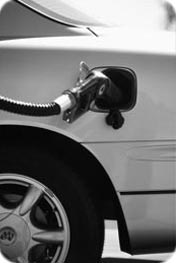Transportation - Energy Efficiency Goals
The Energy Future: Think Efficiency report examines the opportunities and challenges posed by the transportation sector, which consumes 70 percent of the petroleum the United States uses for fuel. Unless we are able to reduce transportation’s use of petroleum, we will continue to be dependent on potentially unreliable sources of foreign oil, and we will continue to send hundreds of billion of dollars to nations that often do not share our values or global outlook.
The Energy Future: Think Efficiency report sets forth near term, medium term, and long term transportation goals for enhancing energy security and reducing global warming through improvements in energy efficiency.
Recommendations
- The federal government should establish policies to ensure that new light-duty vehicles
average 50 miles per gallon or more by 2030. The specific policies are beyond the scope
of this study but could include more aggressive Corporate Average Fuel Economy (CAFE)
standards, financial incentives such as "feebates" (fees for not meeting the standard and
rebates for surpassing it) and carbon taxes.

Vehicle weight can be significantly reduced without compromising safety, resultling in fuel economy savings while reducing traffic injuries and fatalities.
Technologies are available to move beyond the 35 mpg CAFE standard mandated in law by the year 2020. They include further improvements in internal combustion engines; vehicle weight reductions while maintaining vehicle dimensions; and a reasonable mix of vehicles powered by efficient internal combustion engines, diesel engines and improved hybrid technology. The weight of vehicles can be significantly reduced without compromising safety through design and new materials. - Plug-in hybrid electric vehicles (PHEVs), which charge their batteries from the electric grid, could reduce gasoline consumption by more than 60 percent assuming a full fl eet of PHEVs with a range on batteries alone of at least 40 miles. However, plug-in hybrids require more efficient and more durable batteries, able to withstand deep discharges, that are not yet in commercial large-scale production. Given the technical diffi culties faced in developing the batteries, it cannot be assumed that plug-in hybrids to replace the standard American family car will be available at affordable prices in the near term.
- "Time of use" electric-power metering is needed to make nighttime charging of batteries the preferred mode. Improvements in the electric grid must be made in order to handle charging of electric vehicles if daytime charging is to occur on a large scale or when the market penetration of electric vehicles becomes significant.
- An all-electric battery-powered vehicle would reduce to zero the use of petroleum as a fuel for light-duty vehicles. However, achieving the same range as a gasoline-powered car—300 miles is the government target—requires batteries with much larger capacity than is needed for plug-in hybrid electric vehicles (PHEVs). For the standard mid-priced American family vehicle, batteries with the needed energy storage per unit weight and per unit volume do not exist. A long-term R&D program will be required to develop them.
- Hydrogen fuel cell vehicles (FCVs) are not a short-term solution to our oil needs, but rather a long-term option requiring fundamental science and engineering breakthroughs in several areas. Without such breakthroughs, FCVs are unlikely to be more than a niche product. The main challenges are durability and costs of fuel cells, including their catalysts, cost-effective onboard storage of hydrogen, hydrogen production and deployment of a hydrogen-refueling infrastructure.
- The federal government’s current research, development and demonstration program should have a broader focus. A more balanced portfolio is needed now across the full range to enable the deployment of potential medium- and long-range advances in automotive technologies. Increased research is needed in batteries for conventional hybrids, plug-in hybrids and battery electric vehicles, and in various types of fuel cells. This more balanced portfolio is likely to bring significant benefi ts sooner than the current program through the development of a more diverse range of efficient modes of transportation, and will aid federal agencies in setting successive standards for reduced emissions per mile for vehicles.
- Although this report does not examine energy efficiency issues for tractor-trailers and other large trucks, we note that a comprehensive study of the subject recently completed by the National Academy of Sciences, "Review of the 21st Century Truck Partnership," concludes that the Department of Energy funding for the program does not match its goals or needs and that the program needs restructuring.
- There are many areas of long-term basic and applied research that offer unusually promising opportunities for meeting energy efficiency objectives. Among the most notable specifi cally related to transportation are batteries and energy storage, catalysts, fuel cells and thermoelectric devices. These areas of opportunity require close coordination between basic and applied research, a management gap that DOE must address more effectively, as we noted earlier in the section on Near Term Crosscutting Objectives.












